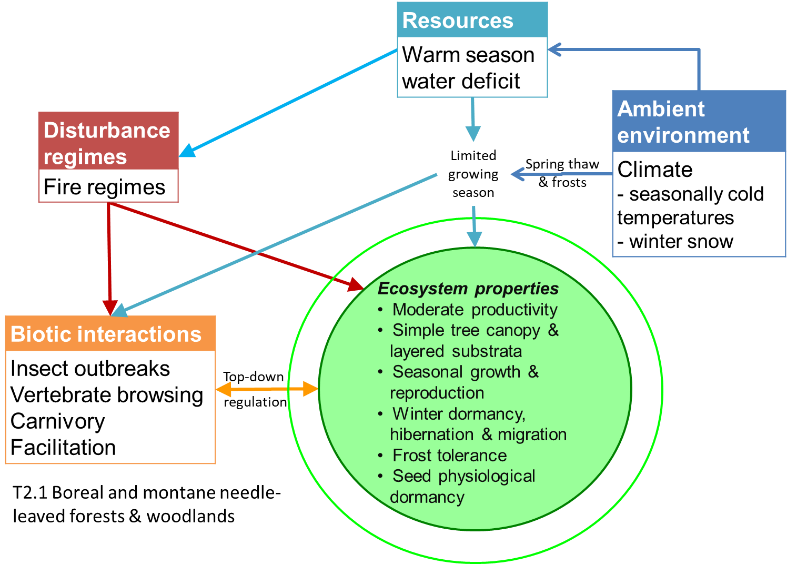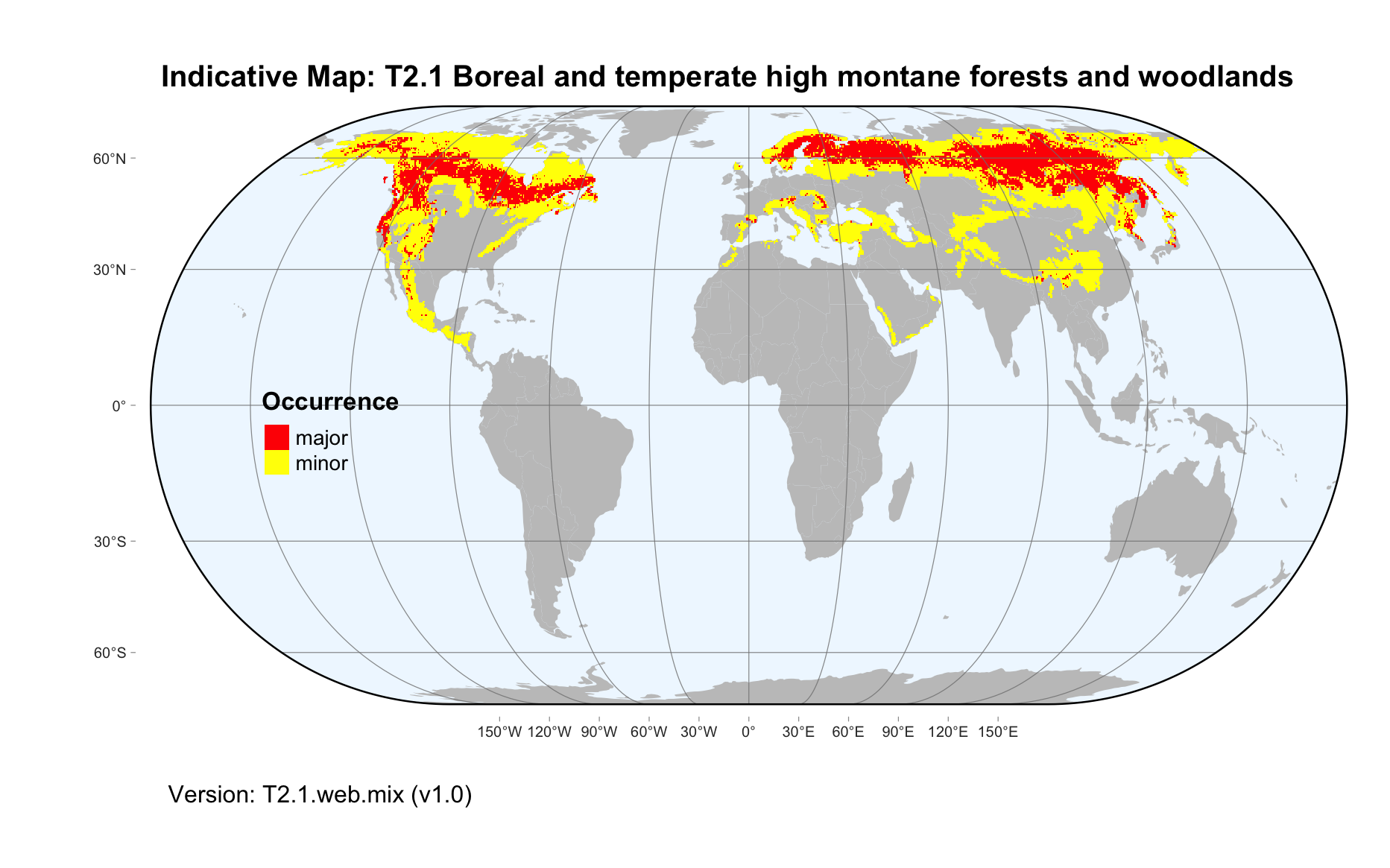Global ecosystem typology
Alternative site for the Global ecosystem typology with additional information for ecosystem profiles and indicative maps.
This site is maintained by jrfep
T2.1 Boreal and temperate high montane forests and woodlands
Biome: T2. Temperate-boreal forests and woodlands biome
Contributors:
(texts)
In boreal and mountainous cold, seasonally snow-prone climates, acid soils support structurally simple forests made up of needle-leaf conifer trees, sometimes with broad-leaf deciduous trees. Large forest trees provide habitat for fungi, mosses and liverworts. Seasonal understorey growth sustains high densities of herbivores such as bear, deer, and a variety of insects, with predators such as lynx, wolves and raptors. Plants and animals survive cold winters through freeze-tolerant organs, hibernation or migratory movements.
Key Features
Closed to open, evergreen (conifers) or deciduous forests in cold climates with short growth periods, low vascular plant species diversity, but abundant cryptogams.
Overview of distribution
Cool regions (boreal zone or mountains in temperate or mediterranean regions) of the Northern Hemisphere, limited occurrences in southern South America.
Profile versions
- v1.0 (2020-01-20): DA Keith; D Faber-Langendoen; T Kontula; J Franklin; NA Brummitt
- v2.0 (2020-06-15): DA Keith; D Faber-Langendoen; T Kontula; J Franklin; NA Brummitt
- v2.01 ():
- v2.1 (2022-04-06): DA Keith; D Faber-Langendoen; T Kontula; J Franklin; NA Brummitt Full profile available at official site
Main references
Selected references for this functional group:
Bonan GB, Shugart HH (1989) Environmental Factors and Ecological Processes in Boreal Forests. Annual Review of Ecology and Systematics 20: 1-28. DOI:10.1146/annurev.es.20.110189.000245
Crawford RMM (2013) Tundra-taiga biology. Ch 5. Oxford University Press, Oxford.
Larsen JA (1980) The boreal ecosystem. Academic Press, New York.
Diagrammatic assembly model

Maps
Maps are indicative of global distribution patterns are not intended to represent fine-scale patterns. The maps show areas of the world containing major (coloured red) or minor occurrences (coloured yellow) of each ecosystem functional group. See general notes on maps.
There are 2 alternative versions of the indicative map for this functional group, please compare description and sources below.
T2.1.IM.mix_v1.0
Datasets
- EarthEnv-LandCover-v1.0
- Resolve-Ecoregions-2017
Map references
Tuanmu, M.-N. and W. Jetz (2014) A global 1-km consensus land-cover product for biodiversity and ecosystem modeling Global Ecology and Biogeography 23(9):1031–1045 DOI:10.1111/geb.12182
Dinerstein E, Olson D, Joshi A, Vynne C, Burgess ND, Wikramanayake E, Hahn N, Palminteri S, Hedao P, Noss R, Hansen M, Locke H, Ellis EE, Jones B, Barber CV, Hayes R, Kormos C, Martin V, Crist E, Sechrest W, Price L, Baillie JEM, Weeden D, Suckling K, Davis C, Sizer N, Moore R, Thau D, Birch T, Potapov P, Turubanova S, Tyukavina A, de Souza N, Pintea L, Brito JC, Llewellyn Barnekow Lillesø JP, van Breugel P, Graudal L, Voge M, Al-Shammari KF, Saleem M (2017) An Ecoregion-Based Approach to Protecting Half the Terrestrial Realm, BioScience 67: 534–545. DOI:10.1093/biosci/bix014. Data-set available on-line
T2.1.web.mix_v1.0

Datasets
- Resolve-Ecoregions-2017
- EarthEnv-LandCover-v1.0
Map references
Dinerstein E, Olson D, Joshi A, Vynne C, Burgess ND, Wikramanayake E, Hahn N, Palminteri S, Hedao P, Noss R, Hansen M, Locke H, Ellis EE, Jones B, Barber CV, Hayes R, Kormos C, Martin V, Crist E, Sechrest W, Price L, Baillie JEM, Weeden D, Suckling K, Davis C, Sizer N, Moore R, Thau D, Birch T, Potapov P, Turubanova S, Tyukavina A, de Souza N, Pintea L, Brito JC, Llewellyn Barnekow Lillesø JP, van Breugel P, Graudal L, Voge M, Al-Shammari KF, Saleem M (2017) An Ecoregion-Based Approach to Protecting Half the Terrestrial Realm, BioScience 67: 534–545. DOI:10.1093/biosci/bix014. Data-set available on-line
Tuanmu, M.-N. and W. Jetz (2014) A global 1-km consensus land-cover product for biodiversity and ecosystem modeling Global Ecology and Biogeography 23(9):1031–1045 DOI:10.1111/geb.12182
Check: the Glossary / Profile structure / the public document